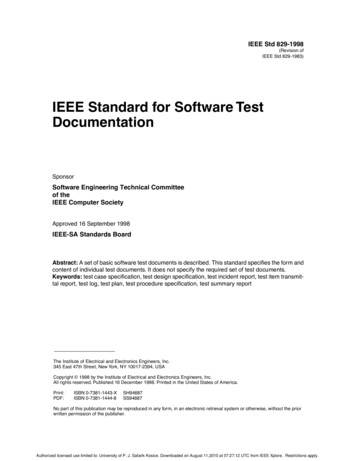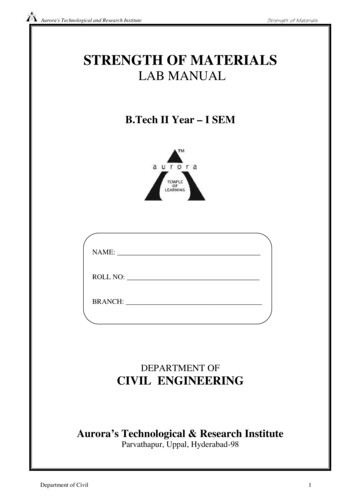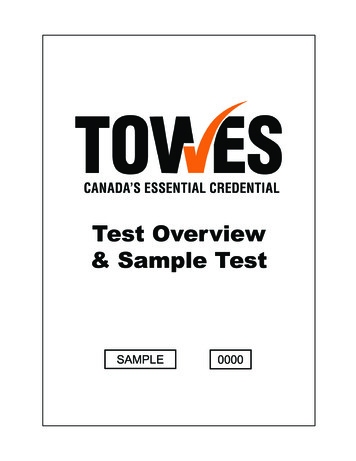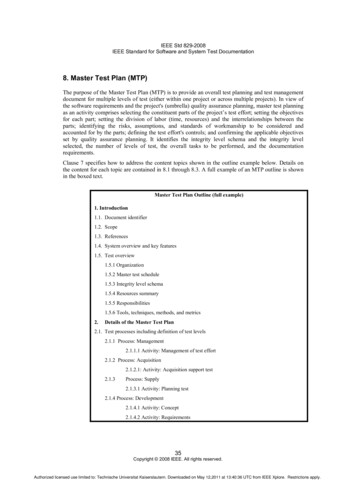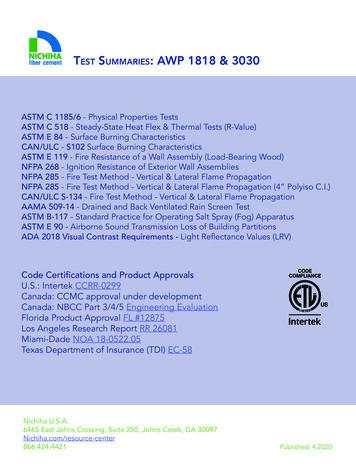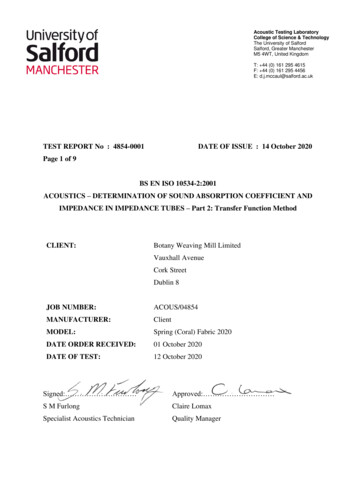
Transcription
Acoustic Testing LaboratoryCollege of Science & TechnologyThe University of SalfordSalford, Greater ManchesterM5 4WT, United KingdomT: 44 (0) 161 295 4615F: 44 (0) 161 295 4456E: d.j.mccaul@salford.ac.ukTEST REPORT No : 4854-0001DATE OF ISSUE : 14 October 2020Page 1 of 9BS EN ISO 10534-2:2001ACOUSTICS – DETERMINATION OF SOUND ABSORPTION COEFFICIENT ANDIMPEDANCE IN IMPEDANCE TUBES – Part 2: Transfer Function MethodCLIENT:Botany Weaving Mill LimitedVauxhall AvenueCork StreetDublin 8JOB NUMBER:ACOUS/04854MANUFACTURER:ClientMODEL:Spring (Coral) Fabric 2020DATE ORDER RECEIVED:01 October 2020DATE OF TEST:12 October 2020Signed: Approved: S M FurlongClaire LomaxSpecialist Acoustics TechnicianQuality Manager
Page 2 of 9Issued by University of Salford (Acoustics Test Laboratory)1TEST SAMPLES1.1Description of Test SamplesTest Reference:4854-0001Sample Reference: Spring (Coral) Fabric 2020Sample Description: DescriptionFour samples cut to 100 mm diameter and 0.7 mm thickness, and four samples cut to29 mm and 0.7 mm thickness were submitted for testing. The samples were mountedloose in the large and small sample holders of the impedance tube respectively.1.2Large mass per unit area:0.3 kg/m2Small mass per unit area:0.3 kg/m2Visible Layers:NonePhotograph.Report No 4854-000114 October 2020
Issued by University of Salford (Acoustics Test Laboratory)2DESCRIPTION OF TEST PROCEDURE2.1Description of Test EquipmentPage 3 of 9Figure 1: Brüel and Kjær Type 4206 Impedance Tube ComponentsThe samples were tested in the Brüel and Kjær Type 4206 Impedance Tube, which hasadapters for both large and small sample holders. When using the small sample adaptation thereare five possible ¼ inch microphone slots, with a 20 mm spacing between the two microphonepositions used during this test. When using the large sample adaptation there are three possible¼ inch microphone slots, with a 100 mm spacing between the two microphone positions usedin this test. Both microphones have a polarisation voltage of 200 V.The small sample holder contains a plunger capable of adjusting the sample position andproviding an air gap to the rear of the sample if desired. The large sample holder has a fittingdevice to ensure the sample remains flush to the edge of the holder.The tube also contains a loudspeaker at one end with its own frequency-weighting unit capableof providing a high-pass filter (for high frequency measurements), linear filter, and low passfilter (for extra accuracy in low frequency measurements). The loudspeaker has a diameter of80 mm and nominal impedance of 4 Ω. The maximum rated input power to the loudspeaker is10 W (at 20 ºC) so voltage supplied to the loudspeaker is kept at 1.141 V during the test. Thedefault filter used for the loudspeaker is linear.The tube is connected to its accompanying Brüel and Kjær PULSE Front-End Analyser, whichworks as a real-time analyser with a pre-installed software package to control the analyser froma PC and perform the measurement calculations.Report No 4854-000114 October 2020
Issued by University of Salford (Acoustics Test Laboratory)2.2Page 4 of 9Test ProcedureThe test procedure follows that detailed in BS EN ISO 10534-2. The PULSE Front-Endanalyser is connected to a PC via a LAN cable, and the ¼ inch microphones connected to theLEMO inputs on the analyser. The analyser is also connected to an amplifier. The loudspeakeris powered via the amplifier, with a voltmeter also connected to ensure correct input signal tothe loudspeaker. The large/small sample holder is attached to the tube.Prior to measurement, the atmospheric pressure, temperature and humidity are recorded, themicrophones are calibrated through the analyser software, the signal-to-noise ratio iscalculated, and a Transfer-Function calibration is also performed.The large/small sample holder is removed and the sample placed in the holder and is checkedto ensure it is flush to the edge of the holder, and no air gaps appear around the diameter of thesample. A broadband random noise is generated by the loudspeaker and the incident andreflected components of the sound field are measured by the two microphones in theirappropriate positions. This is repeated with the microphone positions interchanged. Threefrequency response functions from the measurements are then used by the software to calculatethe reflection and absorption coefficients.Report No 4854-000114 October 2020
Page 5 of 9Issued by University of Salford (Acoustics Test Laboratory)2.3CalculationsThe normal incidence absorption coefficient (α) is calculated using the followingequation:𝛼 1 𝑅 2Where,R is complex reflection coefficient;𝐻12 𝐻𝑖 2𝑗𝑘 𝑥)𝑒 0 1𝑅 (𝐻𝑟 𝐻12Within that,H12 is the complex acoustic transfer function between the two microphonesignals;𝐻12 𝐻𝑟 𝑗𝐻𝑖And,j is the complex integer equivalent to 1 ;Hi is the incident component frequency response function (the complex part ofH12);Hr is the reflected component frequency response function (the real part of H12);k0 is the wavenumber in radians per metre;x1 is the distance between the sample and the further microphone location inmetres.The two microphone transfer function method described in BS EN ISO 10534-2:2001 makesthe assumption on plane wave propagation within the tube with no mean flow and negligiblelosses or absorption along the tube wall. Specifications of the Brüel and Kjær Type 4206Impedance Tube as provided by the manufacturer can be made available on request.Report No 4854-000114 October 2020
Issued by University of Salford (Acoustics Test Laboratory)3Page 6 of 9EQUIPMENTDepartmentalRecord No Brüel and Kjær Type 4206 Impedance Tube Brüel and Kjær PULSE Front-End Generator Dial-A-Watt Power Amplifier129003364 Two Brüel and Kjær ¼ Inch Condenser microphones2677390 &26818692477213/PULSE N.2(attached by tape to their LEMO cables)2677391 Calibrator1795258 Model DA212 AVO avometer Four Banana-Banana cables BNC-BNC cable LAN cable Laptop or PC supporting the B&K PULSE Software,129006085with accompanying PULSE DongleReport No 4854-000114 October 2020
Page 7 of 9Issued by University of Salford (Acoustics Test Laboratory)4RESULTSThe random incidence sound absorption coefficients are given in the tables overleaf.Large sample thickness0.7 mmLarge sample area0.007854 m2Large sample mass perunit area0.3 kgm-2Small sample thickness0.7 mmSmall sample area0.000661 m2Small sample mass perunit area0.3 kgm-2Large SampleSmall SampleTemperature [ C 0.3]21.519.8Rel. humidity [% 3.0]42.448.7Atm. Pressure [kPa 0.2]101100.9The results here presented relate only to the items tested and described in this report.Report No 4854-000114 October 2020
Page 8 of 9Issued by University of Salford (Acoustics Test Laboratory)BS EN ISO 10534-2:2001 Acoustics - Determination of Sound AbsorptionCoefficient in Impedance Tubes; Transfer Function MethodClient:Product Identification:Description of Sample:Curing Time:Botany Weaving Mill LimitedSpring (Coral) Fabric 2020FabricNot ApplicableLarge Sample [50-1600Hz]Temperature:Humidity:Atmos. Pressure:Diameter:Thickness:Mass per Unit Area:Condition:21.5 C42.4 %101.0 kPa100.0 mm0.7 mm20.3 kg/mSatisfactorySmall Sample [500-5000Hz]Temperature:Humidity:Atmos. Pressure:Diameter:Thickness:Mass per Unit Area:Condition:19.8 C48.7 %100.9 kPa29.0 mm0.7 mm20.3 kg/mSatisfactoryNormal incidence sound absorption coefficient, α SFrequencyαS LargeαS SmallαS 70.030.030.050.075000-.-0.080.08Test reference: 4854-0001Date of Test: 12 October 2020University of Salford, School of Computing Science & EngineeringReport No 4854-000114 October 2020
Page 9 of 9Issued by University of Salford (Acoustics Test Laboratory)BS EN ISO 10534-2:2001 Acoustics - Determination of Sound AbsorptionCoefficient in Impedance Tubes; Transfer Function MethodClient:Product Identification:Description of Sample:Botany Weaving Mill LimitedSpring (Coral) Fabric 2020FabricNot ApplicableCuring Time:Large Sample [50-1600Hz]Temperature:21.5 CHumidity:42.4 %Atmos. Pressure:101.0 kPaDiameter:100.0 mmThickness:0.7 mm2Mass per Unit Area:0.3 kg/mCondition:SatisfactorySmall Sample [500-5000Hz]Temperature:19.8 CHumidity:48.7 %Atmos. Pressure:100.9 kPaDiameter:29.0 mmThickness:0.7 mm2Mass per Unit Area:0.3 kg/mCondition:SatisfactoryNormal incidence sound absorption coefficient, α .125003150400050000.030.050.070.081.21.11.0Sound Absorption Coeffincient, a0.90.80.70.60.50.40.30.050801252003155008001250 2000 3150 5000Frequency, HzSigned:Test reference: 4854-0001Date of Test: 12 October 2020University of Salford, School of Computing Science & EngineeringReport No 4854-000114 October 2020
The test procedure follows that detailed in BS EN ISO 10534-2. The PULSE Front-End analyser is connected to a PC via a LAN cable, and the ¼ inch microphones connected to the LEMO inputs on the analyser. The analyser is also connected to an amplifier. The loudspeaker is powered via the amplifier, with a voltmeter also connected to ensure correct input signal to the loudspeaker. The large/small .



